Discover Vietnamese cuisine, a journey through unique and refined flavors. From phở, bún chả, to bánh mì and irresistible street food, Vietnamese cuisine is a perfect blend of fresh ingredients, rich spices, and skillful cooking techniques. Explore the famous specialties and the diverse food culture from different regions of Vietnam to understand why this country has become a must-visit destination for food lovers around the world.
Overview of Vietnamese Cuisine
Vietnamese cuisine is a part of Vietnamese culture. Fish sauce, soy sauce, rice, fresh herbs, fruits and vegetables are the base of recipes. Vietnamese recipes contain a diverse range of herbs, including lemongrass, mint, Vietnamese mint, long coriander and Thai basil leaves. Traditional Vietnamese cooking style focuses on the freshness of the ingredients and the great combination of the dishes. Fish, chicken, pork, beef, and various kinds of seafood are widely used in Vietnamese cuisine. The Vietnamese have a lot of vegetarian food due to the tradition influenced by Buddhist values.
While sharing some key features, Vietnamese culinary tradition differs from region to region. In Northern
Vietnam, a colder climate limits the diversity and availability of spices. As a result, the foods here are often less spicy than in other regions. Black pepper is used in place of chillies as the most popular ingredient to produce spice flavour. In general, Northern Vietnamese cuisine is not bold in any specific flavour - sweet, salty, spicy, bitter, or sour, but mix them subtly to make the taste. Meats such as pork, beef, and chicken were relatively limited in the past. Freshwater fish, crustaceans, and molluscs - such as prawns, shrimps, crabs, oysters and mussels - are widely used. Fish sauce, soy sauce, prawn sauce, and lime are used for seasoning. Northern Vietnam produces many signature dishes of Vietnam, such as pho, bun rieu, banh cuon, which were carried to Central and Southern Vietnam through the road of Vietnamese migration.
All dishes apart from the individual bowls of rice are communal and to be shared.
Popular Vietnamese dishes
Bun cha (rice noodle with BBQ pork)
A simple and popular dish, basically a combination vermicelli plate. Grilled pork (often ground) and vermicelli noodles are served over a bed of greens (salad and sliced cucumber), herbs and bean sprouts. Often includes a few chopped-up egg rolls, spring onions, and shrimp. Served with roasted peanuts on top and a small bowl of 'nuoc cham'.
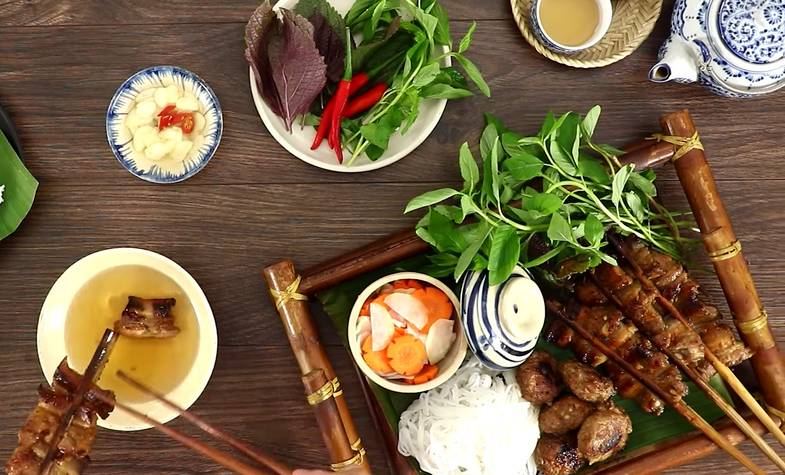
Banh cuon (steam rice paper roll)
Banh cuon is a famous traditional dish in Vietnamese cuisine, especially in the North. This dish is made from a thin batter of rice flour, steamed to create smooth, delicate layers of bánh. The filling typically consists of minced pork, shiitake mushrooms, and fried onions, which together create a delicious and enticing flavor. Bánh cuốn is often enjoyed with a sweet and sour dipping sauce and fresh herbs, offering a balance between the richness of the filling and the tanginess of the sauce. This dish is not only tasty but also very nutritious, commonly served for breakfast or as a light meal. Bánh cuốn has become an essential part of Vietnamese culinary culture, attracting both local and international diners.
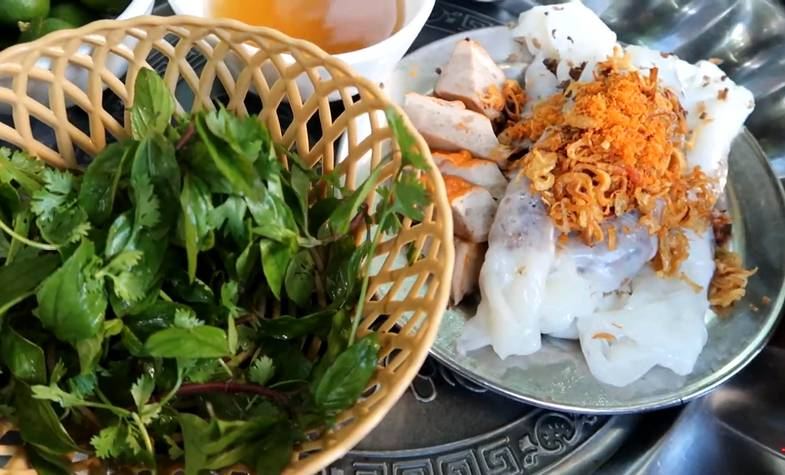
Cha ca La Vong
Cha ca La Vong is a famous dish from Hanoi, known for its distinctive flavor and long history. This dish is made from fresh fish (usually lang fish), marinated with turmeric, dill, and spices, then grilled over charcoal until the fish is golden and fragrant. Chả cá is typically served with fresh rice noodles, herbs, and a special dipping sauce, creating a harmonious blend of the fish's sweetness, the softness of the noodles, and the freshness of the herbs. When enjoying it, diners often wrap the fish and herbs in rice paper, offering a delightful and unique culinary experience. Cha ca La Vong is not just a dish but also an integral part of Hanoi's vibrant food culture.
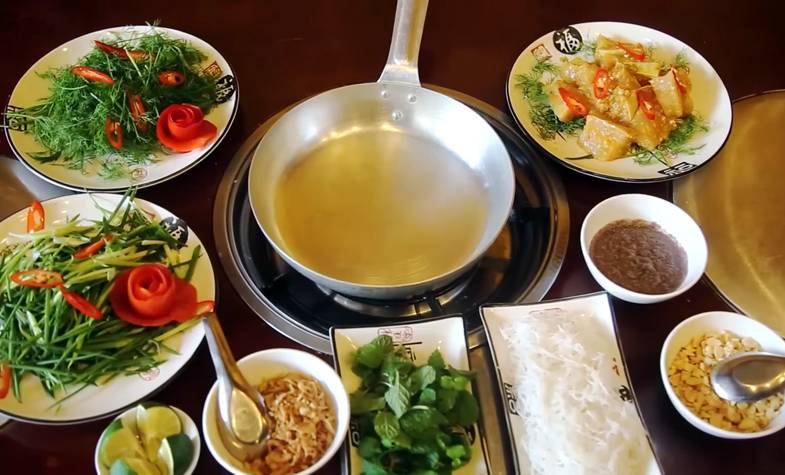
Bun bo Hue (Hue spicy beef noodle)
Bun bo Hue is a signature dish from the city of Hue, renowned for its rich and robust flavors. This dish features fresh rice noodles served in a broth made from simmered beef bones, combined with spices such as lemongrass, chili, and fermented shrimp paste, creating a unique sweet and spicy taste. Bun bo Hue typically includes various types of meat, such as rare beef, pork hocks, and Vietnamese pork sausage, offering a diversity of flavors. It is enjoyed with fresh herbs, bean sprouts, and lime, which add a refreshing touch. Not only is bun bo Hue a delicious dish, but it also symbolizes the culinary culture of Central Vietnam, showcasing the skill and finesse of the local people in its preparation.
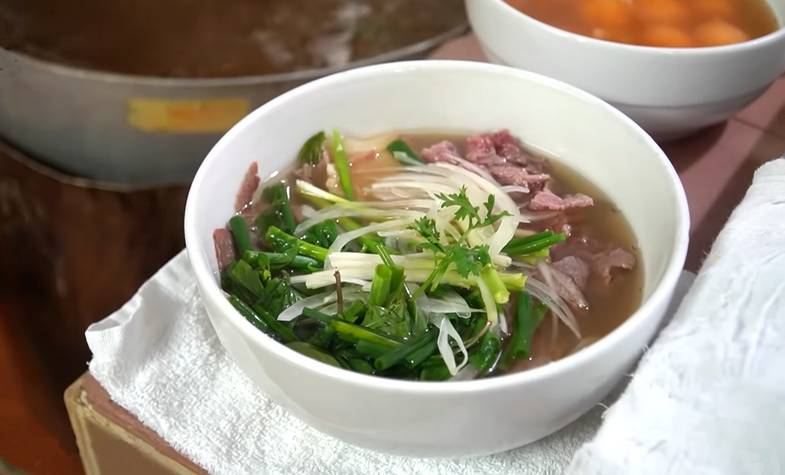
Pho (Noodle)
A noodle soup with a rich, clear broth made from a long boiling of meat and spices. There are many varieties of pho made with different meats (most commonly beef or chicken) along with beef meatballs. Pho is typically served in bowls with spring onion, slices of semi-cooked beef (to be cooked by the boiling hot broth), and broth. In the South, vegetables and various herbs are also added.
Com ga (Vietnamese mint chicken rice)
A dish of rice cooked in chicken stock and topped with chicken that has been fried then shredded and flavoured with mint and other herbs. The rice has a unique texture and taste that the fried mint garnish enhances. Served with a special herb sauce on the side.
Com tam (steamed broken rice)
In general, grilled pork (either ribs or shredded) plus bì (thinly shredded pork mixed with cooked and thinly shredded pork skin plus fried ground rice) over com tam ("broken rice" in Vietnamese) and sweet and sour fish sauce. Other types of meat, prepared in various ways, may be served with broken rice. One can have barbecued beef, pork, or chicken served with broken rice. The rice and meat are served with various greens and pickled vegetables, along with a prawn paste cake, steamed egg and grilled prawns.
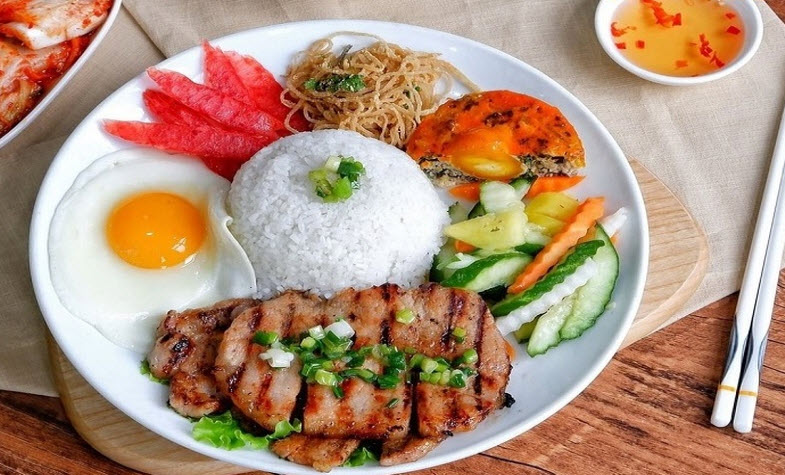
Banh xeo (Vietnamese pancake)
A type of crepe made out of rice flour with turmeric, shrimps with shells on, slivers of fatty pork, sliced onions, and sometimes button mushrooms, fried in one or two teaspoons of oil, usually coconut oil, which is the most popular oil used in Vietnam. It is eaten with lettuce and various local herbs and dipped in light fish sauce or sweet fermented peanut butter sauce. Rice papers are sometimes used as wrappers to contain banh xeo and the accompanying vegetables.
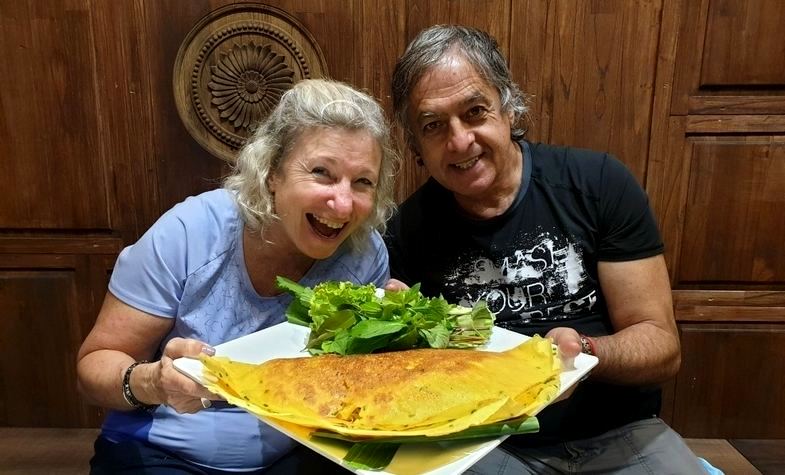
Goi cuon (Salad rolls)
Also known as Vietnamese fresh rolls. They are rice paper rolls that often include shrimp, herbs, pork, rice vermicelli and other ingredients wrapped up and dipped in nuoc cham or peanut sauce. Spring rolls almost constitute an entire category of Vietnamese foods, as there are numerous different kinds of spring rolls with different ingredients in them.
Banh my kep (Vietnamese sandwich)
Vietnamese baguette or French bread containing pâté, Vietnamese mayonnaise, different selections of Vietnamese cold cuts (of which there is a large variety, most commonly ham, head cheese, and Vietnamese bologna), pickled daikon, pickled carrot, and cucumber slices. The sandwich is often garnished with coriander leaves and black pepper. This food is common everywhere in Vietnam as a favourite of factory workers and students, for any meal of the day, commonly breakfast and lunch.
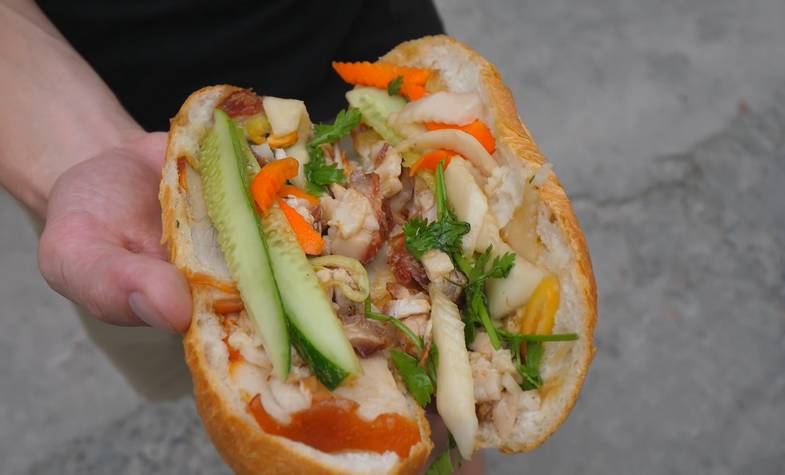
Exotic dishes
The use of ingredients that are typically uncommon or taboo in most countries is one of the quintessential attributes that make Vietnamese cuisine unique. The cobra beating heart and dried bones, silkworms and bull penis are some examples of the dishes he sampled.In some countries, unusual ingredients, most of the time, can be found only in exotic restaurants. What makes the use of these ingredients in Vietnam stand out is that ingredients that are deemed atypical in most countries can play a customary role in daily family dishes, from the poor's to the riches'.
Fertilized duck egg with a nearly developed embryo inside which is boiled and eaten in the shell can be found in any wet market. It is typically served with fresh herbs: rau răm or Vietnamese coriander, salt, and pepper. Paddy crab and paddy snail are the main ingredients in "bun rieu oc" - a popular noodle dish - and in some everyday soup dishes and braised food. Family meals with silkworms, banana flowers, fermented fish and shrimp are not rare sights. Seasonal favourites include ragworm, which is made into many dishes such as fried omelette, fermented sauce,…
Vietnamese cuisine is also notable for its wide range of meat choices. Exotic meat, such as dog meat, snake, soft-shell turtle, deer and domestic goat are widely sold in street-side restaurants and enjoyed with alcoholic beverages. A taboo in many Western countries, the consumption of dog meat is a common sight throughout the country. Paddy mouse meat - barbecued, braised, stir- or deep-fried - is a rarer dish that can be found in many Vietnamese rural areas or even high-end city restaurants.Many of the traditional Northern Lunar New Year’s dishes involve the use of pig heads, tongues, throats and feet. Pig and cow tails as well as chicken heads, necks and feet are Vietnamese favourite beer dishes. Steamed pig brains can be found anywhere along a Vietnamese street.
Delicious desserts from Vietnam
Vietnam is renowned for its unique desserts, which offer a delightful blend of sweet flavors and diverse natural ingredients. Some popular options you can try include:
-
Che: A popular Vietnamese dessert, chè comes in a wide variety of flavors. From mung bean chè to banana chè, each type offers a unique taste combination of sweet syrup, coconut milk, pandan leaves, or mung beans. Chè can be enjoyed hot or cold, depending on the season, and is often served with rich coconut milk.
-
Coconut ice cream is a beloved dessert, especially on hot summer days. It's typically served in a coconut shell and accompanied by soft, chewy young coconut meat, crunchy roasted peanuts, and fragrant coconut syrup. This refreshing treat offers a taste of the tropics.
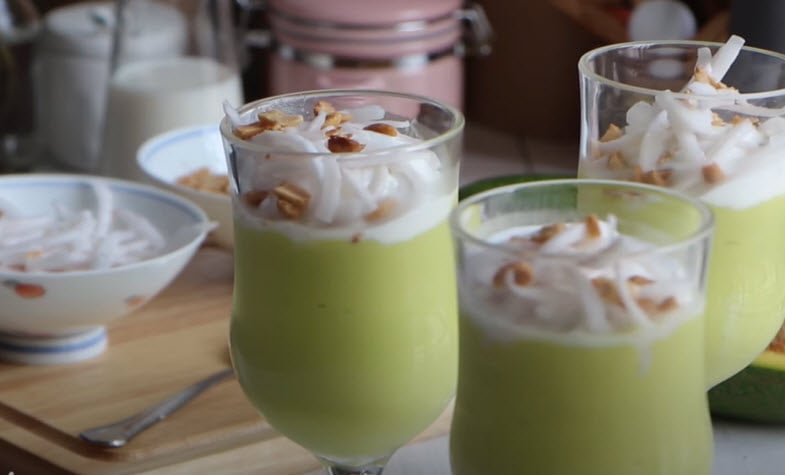
-
Baked banana cake: This traditional dessert offers a simple yet delightful flavor. Bananas are coated in batter and baked until golden brown and crispy on the outside, while remaining soft and sweet on the inside. It's often served with coconut milk and roasted peanuts for a perfect blend of sweet, creamy, and crunchy textures.
-
Pig skin cake: A rustic Southern Vietnamese dessert, this cake features multiple thin layers made from rice flour, pandan leaves, and mung beans, creating a visually appealing and naturally fragrant treat. With its slightly sweet taste and soft, chewy texture, it's perfect for parties or as a snack.
-
Coconut jelly: A refreshing and translucent dessert, coconut jelly is made from fresh coconut water. With its delicate sweetness and subtle coconut flavor, it's the perfect treat for hot summer days.
Our tours you may like:
***
Travel Authentic Asia Company is your best choice for discovering the beauty of Southeast Asia. Our experienced and knowledgeable travel advisors are committed to helping you create a tailor-made tour and extraordinary experiences in this majestic region.
If you're looking for an authentic cultural experience, do not hesitate to contact Travel Authentic Asia to choose a Vietnam tour, Southeast Asia tour package or to customize your own style tour to South East Asia.

